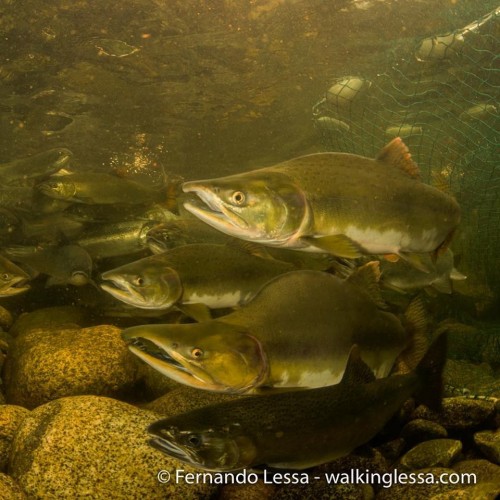Oncorhynchus gorbuscha
Identification Tips:
• Dark elongated spots on entire tail
• Bright silver at sea
• Spawners slate gray backs and dull while below with dark spots on back and tail
• Male spawners have pronounced hump
• Fry are small (< 40 mm), silvery with greenish back and no parr marks
Conservation Status:
| British Columbia | Canada | Natureserve | |
| COSEWIC | Species at Risk Act | ||
| Not at Risk (Yellow List) | Not Assessed | None | G5, S5 |
Information Source: BC Conservation Data Centre: http://a100.gov.bc.ca/pub/eswp/
Life History:
• Spawn in September/October in Fraser River, a few weeks earlier further north
• Females defend redd (nest) until death; all adults die after spawning
• Fry merge from gravel in early spring and quickly migrate downsteam to estuary
• Form large schools in estuary before moving out to sea in July or August
Habitat:
• Most spawn within 100 km of coast, sometimes in tidal waters
• May ascend more than 400 km in Fraser and Skeena Rivers
• Spawn in clean, coarse gravel in 20 - 100 cm depth
• Rear for weeks to months in estuaries before going to sea
Range:
British Columbia
• Occur in most rivers and stream along the BC coast
Global
• Primarily from Puget Sound (Washington) north to Beaufort Sea (Alaska) in North America
• Isolated runs in Sacramento River (California) and Oregon
• No major runs in Columbia River
• North Korea, northern Japan and Siberia
Comments:
• More than 2000 stocks spawn in more than 700 river systems in BC
• Most are very small runs
• 90 % of stocks are considered unthreatened, but at least 17 are extinct
• In most systems Pink Salmon are far more abundant in either odd or even number years
• In Fraser River large runs (sometimes > 20 million) occur in odd number years, but are virtually absent in even number years.
––––––
Primary Information Source:
McPhail, J.D. 2007. The Freshwater Fishes of British Columbia. University of Alberta Press. Edmonton, Alberta.

